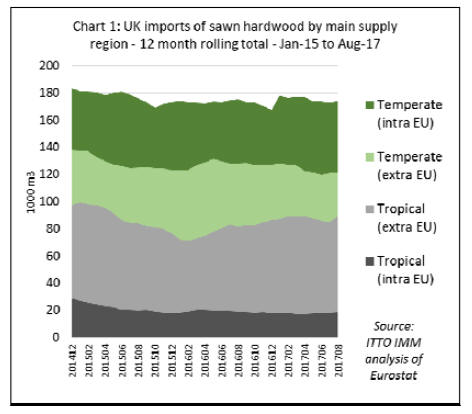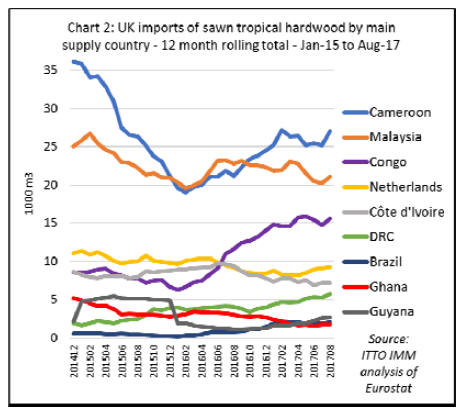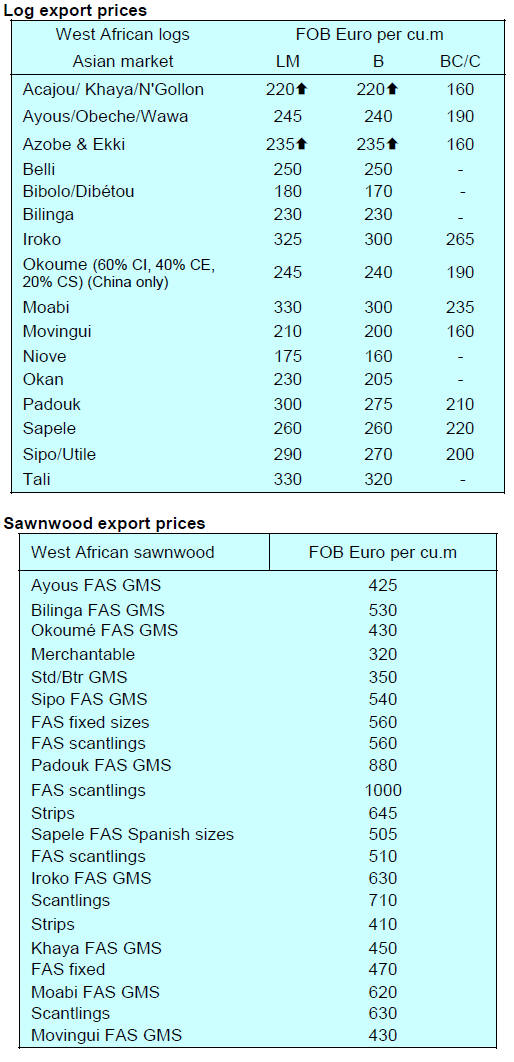|
Report from
Europe
UK sawn hardwood market holds up well despite
Brexit concerns
While imports of tropical sawn hardwood into the
eurozone countries have failed to live up to expectations in
2017, having declined as economic growth has revived,
imports into the UK have followed the opposite trajectory.
UK imports of tropical sawn hardwood have held up well
this year despite slowing economic growth. The UK
imported 70,475 cu.m of sawn tropical hardwood in the
first 8 months of 2017, marginally more than 70,322 cu.m
imported in the same period in 2016.
Chart 1 puts the UK¡¯s relatively strong imports of tropical
sawn hardwood in their wider market context. Total UK
imports of sawn hardwood, both tropical and temperate,
have been consistent at between 170,000 cu.m and
180,000 cu.m per year since the start of 2014.
The moderate growth in UK tropical sawn hardwood
imports this year has come partly at the expense of
temperate hardwood imports which have declined in 2017,
particularly from the USA, Estonia and Italy.

African sapele is by far the dominant tropical hardwood
imported into the UK, being strongly preferred for a wide
range of joinery applications. UK importers report that
sapele prices, which were stable in the first three quarters
of 2017, are now beginning to rise.
They also report that supply of some other popular tropical
hardwoods ¨C such as iroko and meranti ¨C has been limited
this year. However, availability of idigbo and utile has
been good, with stable prices.
This year, demand for sapele in the UK was boosted
following the catastrophic fire at Grenfell Tower which
led to at least 70 deaths in London in June this year. One
outcome of the subsequent nationwide review of fire
safety standards has been withdrawal of approval to use
beech for manufacture of 60-minute fire doors and a
partial switch to sapele in this application.
Chart 2 shows that UK imports of tropical sawn hardwood
from Cameroon have recovered this year following a
significant decline in 2015 and 2016. There has also been
a notable rise in UK imports from the Congo Republic.
Imports from Ghana and Ivory Coast have been sliding
this year.
Imports from Malaysia, mainly of meranti, recovered
ground at the end of 2016, but have been declining in
2017. Imports from Brazil, which fell to negligible levels
in 2014 and 2015, have been slowly recovering in the last
two years.
The EU Timber Regulation has had a major impact on
tropical timber procurement practices in recent years. It
has focused supply on a much more limited range of
companies in tropical countries for which UK importers
are confident of assurances that timber is legally
harvested. In practice this has meant increased demand for
FSC and PEFC certified products.

The fact that UK imports of tropical sawn hardwood have
been rising from DRC this year, and are still high from
Ivory Coast, both countries with no certified forest area,
indicates that other forms of legality assurance are still
being accepted.
Pressure mounts for imports of certified timber
However, the pressure on UK importers to purchase only
certified material is mounting. Many of the UK¡¯s largest
timber distributors are signatories to the WWF Forest
Campaign which commits them to sourcing 100% certified
material by no later than 2020.
Significant changes are already underway in UK imports
of temperate hardwoods. The recent decline in UK imports
from the US, of which around 55% comprises oak, was
initially currency driven. The slide in UK trade in
American hardwood began immediately after the Brexit
vote in June 2016 when the pound plunged in value
against the dollar.
Since then, UK importers have grown accustomed to the
greater uniformity and more appropriate moisture content
of European oak (which is slightly higher and better suits
UK ambient temperatures) compared to US oak and have
been reluctant to switch back even as prices for European
oak have risen. This is particularly true of thicker sizes of
oak, a market which is now heavily dominated by the
European variety.
The decline in UK sawn hardwood imports from the US
this year is also partly due to deteriorating supply of
American ash, now seriously impacted by the emerald ash
borer infestation.
This is devastating ash stocks in the US and has also
encouraged the EU to impose stringent phytosanitary
controls on US ash imports. US suppliers are diverting
most of the ash that is available to markets with less
stringent phytosanitary rules, particularly China where
there is strong demand for the stocks available.
On the other hand, UK imports of American tulipwood
have been consistent, with strong demand for this species
for lighter interior joinery and furniture applications.
Estonia is not traditionally known as a supplier of higher
grade hardwood, and much UK import from the Baltic
state comprises lower grade boreal species such as aspen
and alder used for pallets and other industrial applications.
However, Estonia is also now heavily engaged in thermal
modification of imported hardwoods, notably ash from
other parts of Europe and the US, to supply a product
which competes directly with tropical hardwood in
external applications like decking, cladding and window
frames.
The recent decline in UK imports from Estonia, while
tropical imports have been robust, suggests that tropical
hardwood continues to resist this market pressure from a
potential substitute, at least in certain applications in the
UK.
Slower UK imports of hardwoods from Italy are primarily
due to Croatia¡¯s ban on exports of oak logs and lumber
over 25% moisture content. Italian companies were
heavily engaged in the Croatian oak trade, purchasing logs
and lumber for further processing in Italy for shipment to
the rest of Europe.
However, in June 2017, the Croatian government
implemented the two-year ban on unprocessed oak
exports, ostensibly to stop spread of oak lace beetle ¨C
although some traders suspect a tactic to underpin greater
investment in wood processing in Croatia.
Italian mills are now setting up plants in Croatia to secure
supplies, but lack of kilning capacity is still causing
bottlenecks. European oak prices have risen accordingly,
with another 10% increase anticipated for the new cutting
season.
Stock levels in UK are high
Due to the strong buying activity in the first half of the
2017, UK traders report that hardwood stock levels of
unsold timber on the ground are now quite high. The
September to November period is traditionally very busy
for UK hardwood traders, as customers ramp up buying
between summer vacations and the year-end, but business
has slowed a bit this year.
There is no signs of crises in the UK market just yet, but
many expect demand next year to fall short of the level in
2017. Economic prospects certainly seem to have cooled.
The British Chambers of Commerce (BCC) says that the
UK economy is now on a ¡°low growth trajectory¡±. In its
latest economic review, the BCC revised its growth
forecast for 2018 UK downward, from 1.3% to 1.2%, and
for 2019 from 1.5% to 1.4%.
The BCC says that the post EU referendum slide in the
value of the pound had ¡°done more harm than good¡± as the
rising cost of imported raw materials had driven inflation,
which was now expected to hit 3% by the year end,
suppressing consumer spending.
Uncertainty over Brexit and the UK¡¯s subsequent trade
deal with the EU is cited as a key factor in the deceleration
of the UK economy, with Commerzbank commenting that
it was running at 0.5% slower growth than before the EU
referendum.
UK construction had been on an upward curve, with
housing starts in the year to June up 13% at 164,960. But
the industry contracted in the second and third quarters of
2017 and forecasts for growth in 2018 have been
downgraded to under 1%.
Various industry bodies are now urging the UK
government to push for rapid conclusion of a transition
deal with the EU on Brexit to help lift the economy.
In the meantime, the International Monetary Fund has
revised down long-term and short-term UK growth
forecasts in response to ¡®negative effects¡¯ from the Brexit
vote starting to show. It now predicts the economy will
expand 1.7% this year and 1.5% next.
Falling EU imports of mixed hardwood plywood from
China
After rising strongly in 2016, EU imports of hardwood
plywood have been slowing this year. The decline in
imports has been concentrated in mixed hardwood
products from China. Imports of tropical hardwood
plywood, both directly from tropics and from China, have
been rising this year (Chart 3).
EU imports of hardwood plywood peaked at an annualised
level of 2.80 million cu.m in November 2016, but this
figure had fallen to 2.65 million cu.m by July 2017.
During this period, imports of mixed hardwood plywood
from China fell from an annualised level of 1.03 million
cu.m to 862,000 cu.m.
This decline in imports was partly offset by a rise in
annualised imports of tropical hardwood plywood from
China from 124,000 cu.m in November 2016 to 181,000
cu.m in August 2017.

During the same period, direct imports of hardwood
plywood from tropical countries also increased, from an
annualised level of 356,000 cu.m in November 2016 to
393,000 cu.m in August 2017.
Between November 2016 and August 2017, there were
significant gains in annualised imports from Indonesia
(129,000 cu.m rising to 144,000 cu.m), and Brazil (19,970
cu.m rising to 23,000 cu.m). Imports also increased from a
range of smaller supplying countries including Vietnam,
Thailand, and Morocco.
During the same period, annualised imports were flat from
Malaysia at 123,000 cu.m and declined from Gabon from
38,000 cu.m to 35,000 cu.m.
In terms of destination countries, imports of hardwood
plywood in the UK were broadly flat at an annualised
level of 860,000 cu.m in the 12 months prior to June 2017,
but then slowed sharply to 810,000 cu.m during summer
this year.
Imports in Germany, Belgium, and the Netherlands have
fallen more gradually since the start of 2017, and have
remained stable in Poland and France. (Chart 4).

Regulatory factors appear to have had a significant impact
on the EU hardwood plywood trade this year. EUTR has
encouraged greater concentration of trade into a few larger
suppliers with resources required to meet the due diligence
requirements.
Indonesian plywood appears to have received a boost
since issue of the first FLEGT licenses in November 2016
which allows import of Indonesian product without any
further due diligence.
EUTR coupled with increased technical demands of the
EU Construction Product Regulation has also increased
the trade¡¯s awareness of the importance of accurate
identification of species content for any product placed on
the EU market.
The apparent rise in imports of tropical hardwood
plywood into the EU from China may be at least partly
due to more accurate identification of the actual species
content.
This trend may also be partly due to a greatly increased
range of named species being specifically listed as
¡°tropical non-coniferous¡± rather than ¡°other nonconiferous¡±
following an amendment to the Harmonised
System (HS) of product codes used to compile trade data
from January 2017.
|